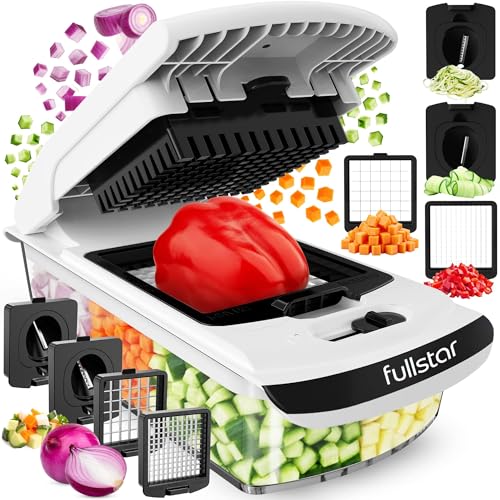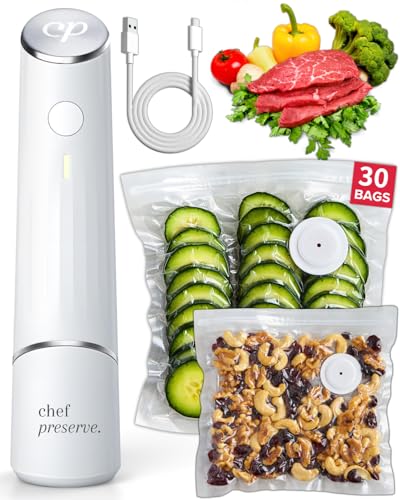Japanese cuisine offers a diverse array of dinner recipes that extend well beyond basic sushi. Favorites include Ramen Noodle Soup, a comforting dish with chewy noodles and rich broth, and Okonomiyaki, a savory pancake packed with vegetables. Other highlights are Yakitori, succulent grilled chicken skewers, and Tonkatsu, a crispy breaded pork cutlet. Each dish showcases unique flavors, from the heartwarming Sukiyaki hot pot to the versatile Donburi rice bowls. Explore these delightful meals for unforgettable culinary experiences.
Ramen Noodle Soup
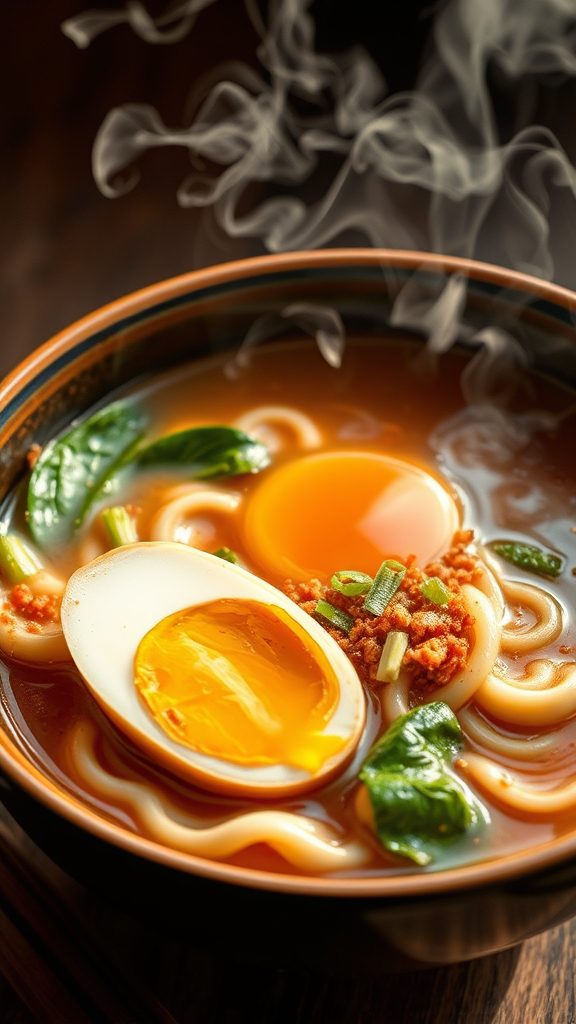
Ramen Noodle Soup is a classic Japanese dish loved by many for its flavorful broth, chewy noodles, and endless customizable toppings.
This comforting bowl of goodness is perfect for a cozy night in or when you're in need of something warming and satisfying. With a preparation time of approximately 30 minutes, it is an ideal meal for both beginners and seasoned cooks looking to whip up a quick and delicious dinner.
Ingredients:
- 4 cups chicken or vegetable broth
- 2 packs of ramen noodles (discard the seasoning packets)
- 2 tablespoons soy sauce
- 1 tablespoon miso paste (optional)
- 1 teaspoon sesame oil
- 2 green onions, sliced
- 1 cup shiitake mushrooms, sliced
- 1 cup baby spinach or bok choy
- 2 soft-boiled eggs (optional)
- Nori (seaweed) sheets, for garnish
- Sesame seeds, for garnish
- Sriracha or chili oil, for heat (optional)
Cooking Steps:
- In a large pot, heat the chicken or vegetable broth over medium heat. Add soy sauce, miso paste (if using), and sesame oil.
- Once the broth is simmering, add the sliced shiitake mushrooms and cook for about 5 minutes until softened.
- Meanwhile, cook the ramen noodles according to package instructions (usually about 3-4 minutes). Drain and set aside.
- Stir in the spinach or bok choy into the broth and let it wilt for 1-2 minutes.
- Add the cooked ramen noodles into the pot and give everything a good stir to combine and heat through.
- Serve the ramen soup hot in bowls, topped with sliced green onions, soft-boiled eggs, torn nori sheets, and a sprinkle of sesame seeds. Drizzle with sriracha or chili oil for an added kick if desired.
Variations and Tips:
- Protein Additions: You can enhance your soup by adding cooked chicken, pork belly, tofu, or shrimp for extra protein.
- Vegetarian/Vegan Option: Use vegetable broth and tofu or firm vegetables like carrots and bell peppers instead of meat.
- Flavor Enhancements: For a richer flavor, consider adding a dash of fish sauce or a tablespoon of chili paste to the broth.
- Make Ahead: The broth can be prepared in advance and stored in the fridge for a few days. Just cook the noodles when you're ready to eat.
- Stir-Fry Option: If you're looking for a variation, stir-fry your choice of vegetables and protein separately, then toss them with cooked ramen and a soy sauce mixture for a noodle stir-fry.
Enjoy your homemade ramen noodle soup, and feel free to customize it to your taste!
- The Original Pro Chopper - Our superstar veggie slicer has been creating waves on TikTok! Simple to use,...
- Easy Meal Prep with Rust-Resistant Blades - Our vegetable chopper is perfect for anyone who wants to eat...
- 5-Star Design - The soft-grip TPU handle ensures controlled chopping, while the non-skid rubber base...
Okonomiyaki: Japanese Savory Pancake

Okonomiyaki is a delightful Japanese savory pancake that beautifully combines a variety of ingredients including cabbage, meat, seafood, and a batter base, making it a versatile dish enjoyed by many.
Often referred to as "Japanese pizza," it's perfect for family gatherings or a fun dinner night, where each person can customize their pancake to their liking. The preparation time is about 20 minutes, with an additional cooking time of around 15 minutes, making it an ideal meal for those looking for something delicious yet quick to prepare.
Ingredients:
- 2 cups all-purpose flour
- 1 cup dashi (Japanese soup stock) or water
- 1 large egg
- 4 cups finely shredded cabbage
- 1/2 cup green onions, chopped
- 1/2 cup cooked bacon or pork belly, sliced
- 1/2 cup shrimp or other seafood (optional)
- Salt and pepper to taste
- Okonomiyaki sauce (for topping)
- Japanese mayonnaise (for topping)
- Aonori (seaweed flakes, for garnish)
- Bonito flakes (for garnish)
Cooking Steps:
- In a large mixing bowl, combine the flour, dashi (or water), and egg. Whisk until smooth and well combined.
- Add the shredded cabbage, green onions, cooked bacon (or pork belly), and shrimp (or other seafood if using) to the batter. Season with salt and pepper, and mix until everything is well coated.
- Heat a non-stick skillet or griddle over medium heat and add a small amount of oil to lightly grease the surface.
- Pour a ladleful of the batter mixture onto the skillet, forming a pancake that is about 1-inch thick and approximately 6-8 inches in diameter.
- Cook for about 5-7 minutes on one side until golden brown. Carefully flip the pancake using a spatula and cook for another 5-7 minutes on the other side.
- Once cooked, transfer the pancake to a plate and drizzle with okonomiyaki sauce and Japanese mayonnaise. Top with aonori and bonito flakes.
- Repeat the process with the remaining batter until all the pancakes are cooked.
Variations and Tips:
- Experiment with fillings: You can use other proteins like chicken, beef, or even tofu for a vegetarian option. Grated carrots or other vegetables can also add variety.
- Serve alongside a side salad or miso soup for a full meal experience.
- To make mini okonomiyaki, use smaller portions of batter to create bite-sized pancakes, perfect for sharing as appetizers.
- For an extra crispy edge, let the pancakes cook a little longer, and use a bit more oil in the pan.
- To make it healthier, consider substituting half of the flour with whole wheat flour and increasing the vegetables in the mixture.
- Makes Everything Simple : Just forget your bagged cheese! Only turn the handle for several times and get...
- Premium Material : All parts of the rotary cheese grater are made of food grade ABS material, no BPA. The...
- Three Option Grater : The parmesan cheese grater finishes food preparation with slicing, shredding and...
Donburi: Rice Bowl Variations

Donburi is a versatile and comforting Japanese rice bowl dish that features a flavorful topping served over a bed of steamed rice. It is perfect for those looking for a quick yet satisfying meal, ideal for families and busy individuals alike. With a preparation time of about 30 minutes, donburi can be easily customized to accommodate different tastes and dietary needs.
Ingredients:
- 2 cups cooked Japanese short-grain rice
- 1 cup protein of choice (chicken, beef, shrimp, tofu)
- 1 small onion, sliced
- 1 cup vegetables (bell peppers, broccoli, carrots)
- 1 tablespoon soy sauce
- 1 tablespoon mirin (optional)
- 1 tablespoon sake (optional)
- 1 teaspoon sugar
- 2 tablespoons cooking oil
- Chopped green onions for garnish
- Sesame seeds for garnish
- Nori strips for garnish (optional)
Cooking Steps:
- Prepare the Rice: Start by cooking the Japanese short-grain rice according to the package instructions. When done, keep it warm.
- Cook the Protein: In a large skillet, heat the cooking oil over medium heat. Add the sliced onion and sauté until translucent. Then, add your protein choice, cooking until it's fully cooked through.
- Add Vegetables: Once the protein is cooked, add your chosen vegetables to the skillet. Stir-fry for about 3-5 minutes until the vegetables are tender but still crisp.
- Make the Sauce: In a small bowl, mix together the soy sauce, mirin, sake, and sugar. Pour this mixture over the protein and vegetable mixture, stirring to coat everything evenly. Let it simmer for 2-3 minutes to combine the flavors.
- Assembly: In individual bowls, serve a generous portion of the warm rice. Top each bowl with the protein and vegetable mixture.
- Garnish: Sprinkle with chopped green onions, sesame seeds, and nori strips if desired. Serve immediately.
Variations and Tips:
- Protein Variations: Try different proteins like pork, fish, or a plant-based option like tempeh for a vegetarian version.
- Vegetable Variations: Use seasonal vegetables or whatever you have on hand, such as snap peas, mushrooms, or zucchini.
- Spice It Up: For a kick, add a dash of chili oil or some sliced fresh chili peppers to the skillet.
- Add an Egg: A common addition to donburi is a fried or poached egg on top, which adds richness to the dish.
- Serving Style: For a fun twist, serve the donburi components separately and let diners assemble their bowls according to their preference.
- 💰 REDUCE WASTE AND SAVE MONEY: Chef Preserve keeps FOOD FRESH 5 TIMES LONGER than non-vacuum storage...
- ✅ POWERFUL, QUICK & EASY TO USE: Simply press the button to start. The device vacuum seals a bag in 5...
- ♻️ REUSABLE & RESEALABLE BAGS: Chef Preserve comes with dishwasher, freezer, refrigerator, and...
Yakitori: Grilled Chicken Skewers

Yakitori is a popular Japanese dish that consists of skewered and grilled chicken, often seasoned with a savory sauce or simply salted for a delightful flavor. This dish is perfect for sharing at gatherings, barbecues, or as a fun weeknight dinner.
With a preparation time of about 20 minutes and a cooking time of 10-15 minutes, you can enjoy this delectable dish in no time.
Ingredients:
- 1 pound boneless chicken thighs, cut into bite-sized pieces
- 1/4 cup soy sauce
- 1/4 cup mirin (sweet rice wine)
- 2 tablespoons sake (Japanese rice wine)
- 2 tablespoons sugar
- 1 tablespoon sesame oil
- 1-2 green onions, sliced into 1-inch pieces
- Bamboo skewers (soaked in water for 30 minutes)
- Salt and pepper, to taste
Cooking Steps:
- In a bowl, whisk together soy sauce, mirin, sake, sugar, and sesame oil to create the marinade.
- Add the chicken pieces to the marinade, ensuring they are well coated. Allow them to marinate for at least 15 minutes.
- Preheat a grill or grill pan over medium-high heat.
- Thread the marinated chicken pieces and green onion slices onto the soaked bamboo skewers, alternating between chicken and green onion as desired.
- Season the skewers lightly with salt and pepper.
- Place the skewers on the grill and cook for about 10-15 minutes, turning occasionally, until the chicken is fully cooked and has grill marks. Brush with extra marinade while grilling for added flavor.
- Once ready, remove skewers from the grill and let them rest for a couple of minutes before serving.
Variations and Tips:
- For a different flavor profile, you can use chicken breast instead of thighs or mix other proteins like beef or vegetables.
- Try adding a variety of vegetables such as bell peppers, mushrooms, or zucchini for a colorful twist.
- Serve with a sprinkle of shichimi togarashi (Japanese seven-spice blend) or a drizzle of spicy mayo for an extra kick.
- Yakitori can be enjoyed with rice or as part of a larger Japanese-style meal.
- Generous Capacity: 7-quart slow cooker that comfortably serves 9+ people or fits a 7-pound roast
- Cooking Flexibility: High or low slow cooking settings, with convenient warm function for ideal serving...
- Convenient: Set it and forget it feature enables you to cook while at work or performing daily tasks
Tonkatsu: Breaded Pork Cutlet
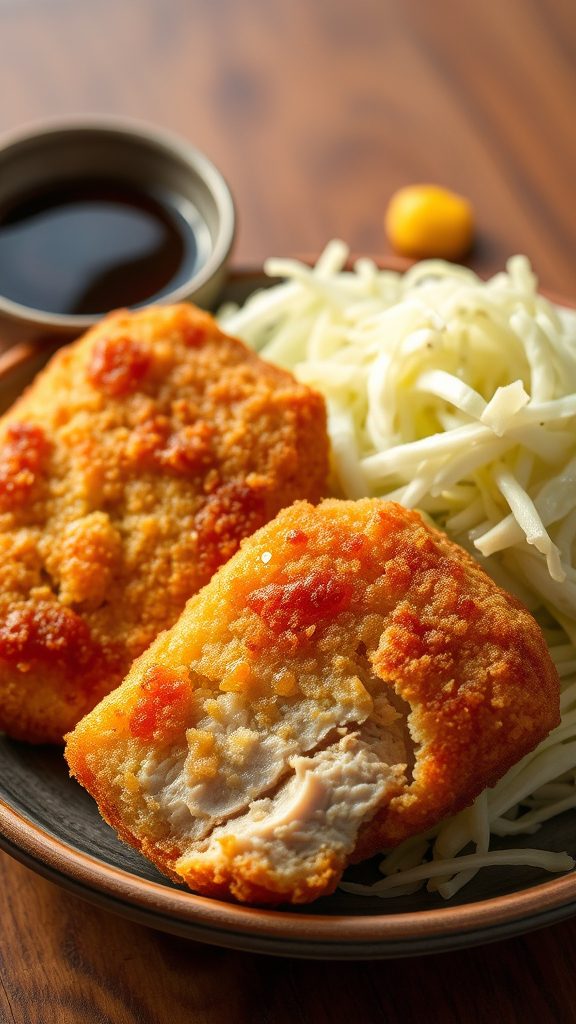
Tonkatsu is a delicious Japanese dish consisting of a breaded and deep-fried pork cutlet, typically served with shredded cabbage and a tangy tonkatsu sauce. This hearty meal is perfect for families or gatherings, offering satisfying flavors that appeal to both adults and children alike.
With a preparation time of around 20 minutes and a cooking time of approximately 15 minutes, you can have this iconic dish ready in about 35 minutes.
Ingredients:
- 2 boneless pork loin chops (approximately 1 inch thick)
- Salt and pepper (to taste)
- 1/2 cup all-purpose flour
- 1 large egg (beaten)
- 1 cup panko breadcrumbs
- Oil for frying (vegetable or canola oil)
- Tonkatsu sauce (for serving)
- Shredded cabbage (for serving)
- Lemon wedges (optional)
Cooking Instructions:
- Start by prepping the pork chops. Lightly pound the pork loin chops with a meat mallet to an even thickness (about 1/2 inch), then season both sides with salt and pepper.
- Set up a breading station: place the flour in one shallow dish, the beaten egg in another, and the panko breadcrumbs in a third dish.
- Dredge each pork chop in flour, shaking off any excess. Then dip it into the beaten egg, making sure to coat it evenly. Finally, coat the pork chop with panko breadcrumbs, pressing gently to adhere the crumbs.
- In a large frying pan or skillet, heat about 1/2 inch of oil over medium heat until hot (about 350°F or 175°C).
- Carefully place the breaded pork chops into the hot oil, cooking for about 5-7 minutes on each side, or until golden brown and cooked through. Use a meat thermometer to verify the internal temperature reaches 145°F (63°C).
- Once cooked, transfer the tonkatsu to a paper towel-lined plate to drain excess oil. Let rest for a couple of minutes before slicing into strips.
- Serve Tonkatsu with tonkatsu sauce drizzled on top or on the side, alongside shredded cabbage and lemon wedges if desired.
Variations and Tips:
- For a healthier version, you can bake the breaded pork chops at 400°F (200°C) for about 20-25 minutes or until cooked through, turning them halfway through.
- Substitute pork loin with chicken breast or tofu for a different protein option.
- Experiment with adding spices or herbs to the panko breadcrumbs for a unique flavor twist, such as garlic powder or dried herbs.
- Pair your tonkatsu with a side of rice or miso soup for a complete Japanese meal.
- Make certain the oil is hot enough before frying to achieve the perfect crispy texture. If the oil is not hot, the breading will absorb excess oil and become soggy.
- 100% Leak-proof: Guaranteed no-spill seal and secure latches
- Crystal-clear Tritan Built: Stain-resistant and odor-resistant material for a clear view of contents
- Lightweight & Sturdy: Easy to carry, yet durable for everyday use
Sukiyaki: Japanese Hot Pot

Sukiyaki is a popular Japanese hot pot dish that combines thinly sliced beef, a variety of vegetables, and tofu cooked in a flavorful, sweet-savory broth made of soy sauce, sugar, and mirin. This dish is ideal for family gatherings or cozy dinners with friends, as it fosters a communal dining experience—everyone cooks and enjoys their meal together right at the table. The preparation time for Sukiyaki is approximately 30 minutes, with additional cooking time depending on the amount of ingredients used.
Ingredients:
- 1 lb (450g) thinly sliced beef (ribeye or sirloin)
- 1/2 cup soy sauce
- 1/4 cup mirin
- 1/4 cup sugar
- 1/2 cup sake (optional)
- 1 block of firm tofu, cut into cubes
- 1 cup shiitake mushrooms, sliced
- 1 large onion, thinly sliced
- 2 cups napa cabbage, chopped
- 1 cup green onions, cut into 2-inch pieces
- 1 cup mung bean sprouts
- Cooked rice or udon noodles for serving
- Beaten raw egg (optional, for dipping)
Cooking Steps:
- Prepare the Broth: In a bowl, mix soy sauce, mirin, sugar, and sake (if using). Stir until the sugar is dissolved.
- Heat the Pan: In a large skillet or shallow pot, heat a small amount of oil over medium-high heat. Add the sliced beef and sear it briefly until browned.
- Add the Vegetables and Tofu: Once the beef is browned, push it to one side and add the onions, mushrooms, and tofu to the pot. Pour the broth mixture over the top.
- Cook and Simmer: Bring the mixture to a simmer, allowing the ingredients to cook and flavors to meld, about 10-15 minutes. Stir occasionally.
- Add Remaining Ingredients: Mix in the napa cabbage and green onions towards the end, letting them wilt slightly. Finally, add the mung bean sprouts and allow to cook for another couple of minutes.
- Serve: Serve the Sukiyaki hot straight from the pot. Diners can dip pieces of cooked meat and vegetables in beaten raw egg before eating. Offer rice or udon noodles on the side to balance the meal.
Variations and Tips:
- Vegetable Swaps: Feel free to use other vegetables such as carrots, bell peppers, or bok choy based on personal preference.
- Protein Options: Besides beef, you can use chicken, pork, or even a mix of proteins. For a vegetarian version, substitute mushrooms for meat and use vegetable broth.
- Cooking Method: If you have a portable burner, consider cooking at the table for an interactive experience.
- Leftover Idea: Any leftover Sukiyaki can be stored in the refrigerator and enjoyed the next day; just reheat, and serve with fresh rice or noodles.
- 𝗘𝗳𝗳𝗼𝗿𝘁𝗹𝗲𝘀𝘀 𝗪𝗲𝗶𝗴𝗵𝗶𝗻𝗴: Supports 5 units...
- 𝗣𝗿𝗲𝗰𝗶𝘀𝗲 𝗥𝗲𝘀𝘂𝗹𝘁𝘀: Accurately weighs up to 11 lb/5 kg with 1 g...
- 𝗦𝗶𝗺𝗽𝗹𝗲 & 𝗖𝗼𝗺𝗽𝗮𝗰𝘁: The small and sleek scale is a perfect fit for...
Udon Noodles With Tempura
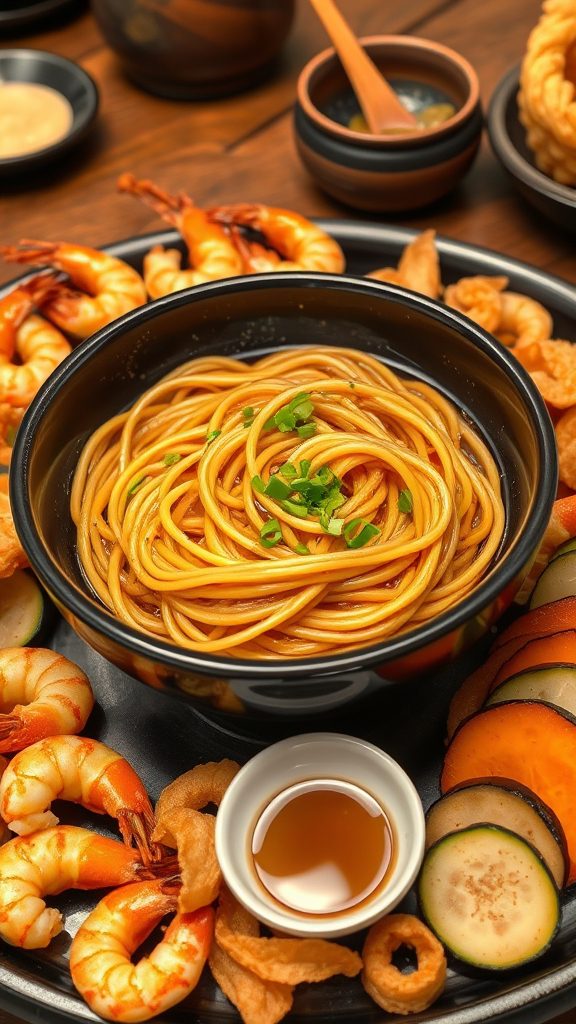
Udon Noodles With Tempura is a delightful Japanese dish that features thick, chewy udon noodles served in a savory broth, accompanied by crispy tempura vegetables and shrimp.
Ideal for family dinners or gatherings, this dish is not only satisfying but also visually appealing, making it a favorite among both adults and children. The preparation time is approximately 30 minutes, with an additional 20 minutes for cooking the tempura, making it a wonderful meal to prepare when you want something special without spending all day in the kitchen.
Ingredients:
- 400g udon noodles
- 1 liter dashi broth (can use premade or homemade)
- 2 tablespoons soy sauce
- 1 tablespoon mirin (sweet rice wine)
- 1 teaspoon salt
- 1 medium carrot, julienned
- 1 zucchini, thinly sliced
- 8-10 shrimp, peeled and deveined
- 1 cup tempura batter mix
- 1 cup cold water (for tempura batter)
- Oil for frying (vegetable or canola)
- Green onions, chopped (for garnish)
- Shredded nori (seaweed, for garnish)
Cooking Steps:
- Prepare the Udon Noodles: Cook the udon noodles according to the package instructions, then drain and set aside.
- Make the Broth: In a pot, heat the dashi broth over medium heat. Add soy sauce, mirin, and salt. Allow the broth to simmer gently while you prepare the tempura.
- Prepare the Tempura Batter: In a bowl, mix the tempura batter mix with cold water until it reaches a lumpy consistency (do not overmix).
- Heat the Oil: In a deep pan or pot, heat about 2 inches of oil over medium-high heat. You can test if the oil is hot enough by dropping a small amount of batter into the oil; it should sizzle and rise immediately.
- Cook the Tempura: Dip the shrimp and vegetables (carrots and zucchini) into the tempura batter, ensuring they are well-coated. Carefully place them into the hot oil, a few pieces at a time, and fry until golden brown (about 2-3 minutes). Remove and drain on paper towels.
- Assemble the Dish: Divide the cooked udon noodles among bowls. Ladle the hot broth over the noodles. Top with crispy tempura, chopped green onions, and shredded nori.
- Serve: Enjoy your udon noodles with tempura while hot!
Variations and Tips:
- Vegetable Options: You can include other vegetables for tempura, such as sweet potato, mushrooms, or green beans.
- Broth Variations: Feel free to add additional seasonings to the broth or even some sliced mushrooms for added flavor.
- Make it Spicy: If you prefer a spicy kick, add some chili oil or serve with shichimi togarashi (Japanese seven-spice blend).
- Tempura Flour: For a lighter tempura batter, consider using a tempura flour mix designed for frying.
- Meal Prep: You can prepare broth and cut vegetables ahead of time to make the cooking process quicker.
- Instant Read Food Thermometer | Our instant read thermometer features a temperature probe and advanced,...
- Multi-Use | From bbq thermometer to baking thermometer, our digital food thermometer for cooking is...
- Easy-Read Digital Thermometer For Cooking | Large instant thermometer dial with bright blue backlight...
Miso Soup: A Comforting Classic
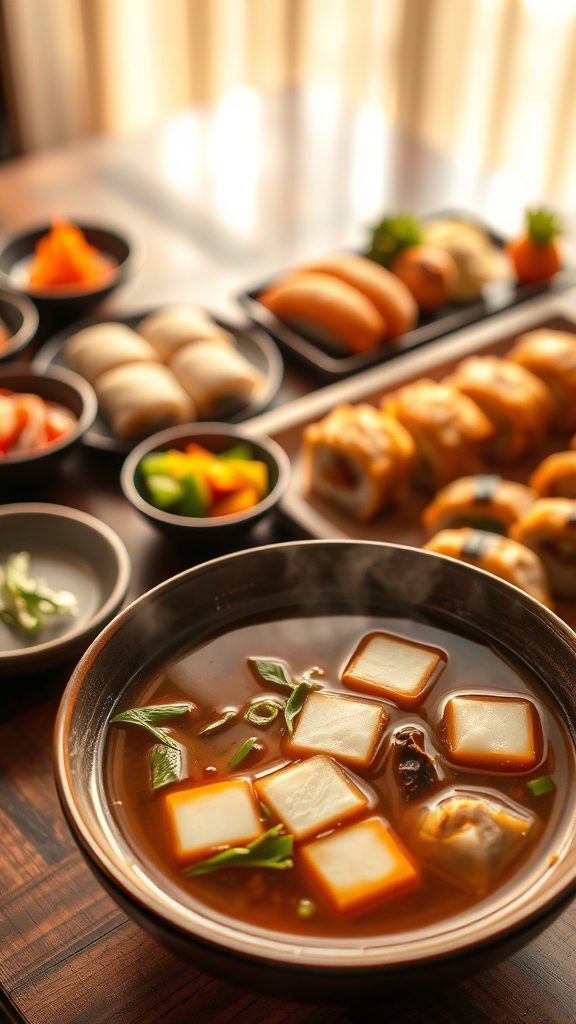
Miso soup is a classic Japanese dish known for its comforting flavors and health benefits. This warm and savory soup is made from dashi (a traditional Japanese broth) and miso paste, often enjoyed as part of a meal or as a soothing remedy on a chilly day.
Perfect for both beginners and seasoned cooks alike, Miso Soup typically takes around 20 minutes to prepare and serves approximately four people. It's not only a staple in Japanese households but also a popular choice for those looking for a quick, nutritious, and delicious meal.
Ingredients:
- 4 cups dashi (Japanese soup stock)
- 3-4 tablespoons miso paste (white or red)
- 1 cup tofu (firm or silken, cubed)
- 1 cup green onions (sliced)
- 1 cup wakame seaweed (dried)
- Optional: mushrooms (shiitake or enoki), daikon radish, or other vegetables
Cooking Steps:
- Start by making the dashi. If using instant dashi powder, dissolve it in 4 cups of water in a pot and bring it to a simmer. If making dashi from scratch, simmer kombu (dried seaweed) and bonito flakes in water, then strain the solids.
- Once the dashi is ready and simmering, take a small bowl and add the miso paste. Ladle a small amount of the hot dashi into the bowl with the miso, whisking it together until smooth to create a miso slurry.
- Add the miso mixture back into the pot with the dashi, stirring well to combine the flavors. Make sure not to boil the soup after adding the miso as it can lose its beneficial properties.
- Sprinkle in the cubed tofu and seaweed, allowing them to warm through for about 2-3 minutes.
- Finally, stir in the sliced green onions just before serving. Taste and adjust the miso according to your preference for saltiness.
Variations and Tips:
- For a heartier soup, consider adding sliced mushrooms, shredded carrots, or diced daikon radish.
- If you like a richer flavor, experiment with using red miso paste, which has a stronger taste compared to white miso.
- Store leftovers in the fridge and reheat gently; however, it's best to consume the soup fresh, as the texture of the tofu may change.
- Miso soup can be enjoyed as a side dish or paired with a bowl of rice and seasonal vegetables for a light meal.
- Versatile 54-Piece Collection: Elevate your kitchen with the Home Hero 54-Piece Kitchen Utensil Set, a...
- Durable and Long-Lasting: Crafted from premium stainless steel, these kitchen utensils are designed to...
- Perfect Holiday Gift: Delight your loved ones with this kitchen utensils gift set this festive season....
Nikujaga: Meat and Potato Stew

Nikujaga is a beloved Japanese home-cooked dish that combines tender meat, potatoes, and onions simmered in a sweet-savory broth. This hearty stew is particularly popular among families and is often considered a comfort food in Japan.
It's easy to prepare, making it perfect for busy weekdays or cozy family dinners. The preparation time for Nikujaga is approximately 15 minutes, with a total cooking time of about 30 minutes.
Ingredients:
- 300g thinly sliced beef (or pork)
- 4 medium potatoes, peeled and cut into bite-sized pieces
- 1 medium onion, sliced
- 2 carrots, sliced
- 2 cups dashi stock (or water)
- 5 tablespoons soy sauce
- 3 tablespoons sake
- 2 tablespoons sugar
- 1 tablespoon mirin (optional)
- Green onions (for garnish, optional)
Cooking Steps:
- In a large pot, heat a tablespoon of oil over medium heat. Add the sliced onions and sauté until they become translucent.
- Add the sliced beef (or pork) to the pot and cook until browned.
- Stir in the potatoes and carrots, mixing well.
- Pour in the dashi stock (or water), and then add the soy sauce, sake, sugar, and mirin.
- Bring the mixture to a boil, then reduce heat to low and cover the pot. Let it simmer for about 20 minutes, or until the vegetables are tender.
- Taste and adjust seasoning if necessary, allowing for a bit more soy sauce or sugar based on your preference.
- Serve hot, garnished with green onions if desired.
Variations & Tips:
- For a healthier option, you can use chicken breast or tofu instead of beef.
- Consider adding additional vegetables like mushrooms or green beans for more flavor and nutrition.
- Serve Nikujaga over a bed of steamed rice for a complete meal.
- Leftovers can be refrigerated and reheated, but the texture of the vegetables might soften more.
- 24-ounce insulated stainless-steel water bottle with a FreeSip spout and push-button lid with lock
- Patented FreeSip spout designed for either sipping upright through the built-in straw or tilting back to...
- Protective push-to-open lid keeps spout clean; convenient carry loop doubles as a lock
Yaki Udon: Stir-Fried Noodles
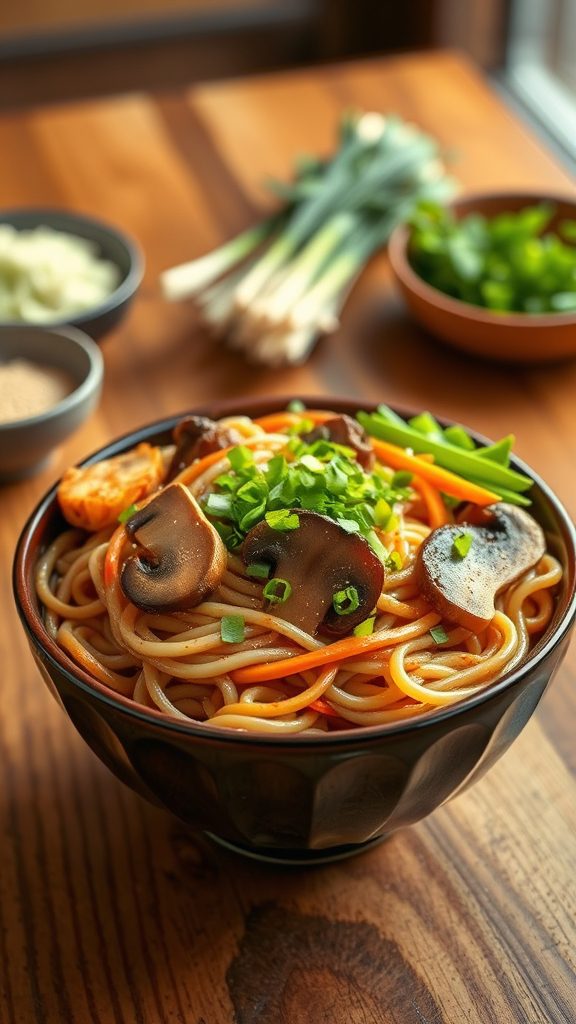
Yaki Udon is a hearty stir-fried noodle dish that hails from Japan, featuring thick wheat noodles tossed with a variety of vegetables and proteins, all coated in a savory sauce. This dish is perfect for those who love rich, umami flavors and is ideal for both a quick weeknight dinner and a relaxed meal with friends or family.
In just about 30 minutes, you can whip up a delicious and satisfying meal that can be easily customized according to your preference.
Ingredients:
- 300g udon noodles
- 2 tablespoons vegetable oil
- 1 medium onion, sliced
- 2 cloves garlic, minced
- 1 carrot, julienned
- 1 bell pepper, sliced
- 100g mushrooms, sliced
- 200g protein of choice (chicken, beef, tofu, shrimp)
- 3 tablespoons soy sauce
- 1 tablespoon oyster sauce (optional)
- 1 tablespoon mirin (optional)
- Salt and pepper to taste
- Spring onions, chopped (for garnish)
- Sesame seeds (for garnish)
Cooking Instructions:
- Cook the udon noodles according to package instructions. Drain and set aside.
- Heat the vegetable oil in a large skillet or wok over medium-high heat.
- Add the sliced onion and minced garlic, cooking until the onion becomes translucent.
- Incorporate the julienned carrot and sliced bell pepper, and stir-fry for about 2-3 minutes.
- Add the sliced mushrooms and your choice of protein to the skillet, cooking until the protein is fully cooked through.
- Stir in the cooked udon noodles, soy sauce, oyster sauce, and mirin, mixing everything well until the noodles are heated through and coated with sauce.
- Season with salt and pepper to taste, adjusting as necessary.
- Remove from heat, and serve hot, garnished with chopped spring onions and sesame seeds.
Variations and Tips:
- For a vegetarian option, use firm tofu or tempeh as the protein and omit oyster sauce.
- Feel free to add other vegetables such as snow peas, broccoli, or bok choy to enhance the nutritional value.
- If you prefer a spicier dish, add a pinch of red pepper flakes or drizzle with sriracha before serving.
- Yaki Udon can be made ahead of time; just reheat before serving, adding a dash of water to keep the noodles from drying out.
- Experiment with different sauces like teriyaki or soy-noodle stir-fry sauce for unique flavor profiles.
Chawanmushi: Savory Custard

Chawanmushi is a classic Japanese savory custard that showcases the delicate flavors of dashi, soy sauce, and seasonal ingredients. This dish is light yet satisfying, making it perfect for a family dinner or an elegant appetizer for guests.
The preparation time is relatively quick, taking about 15 minutes of prep and 30 minutes of steaming, resulting in a dish that can be enjoyed at any time of the year.
Ingredients:
- 4 large eggs
- 2 cups dashi (Japanese soup stock)
- 2 tablespoons soy sauce
- 1 tablespoon mirin
- 1/2 teaspoon salt
- 1/2 cup cooked shrimp, chopped
- 1/2 cup cooked chicken breast, shredded
- 1/4 cup shiitake mushrooms, sliced
- 1/4 cup green onions, chopped
- Optional: small pieces of carrot or peas for garnish
Instructions:
1. In a mixing bowl, whisk together the eggs gently, being careful not to create too many bubbles.
2. In a separate bowl, combine dashi, soy sauce, mirin, and salt. Gradually add this mixture to the beaten eggs, continuing to whisk gently until everything is incorporated.
3. Strain the egg mixture through a fine sieve into another bowl to remove any lumps and guarantee a silky texture.
4. Distribute the shrimp, chicken, mushrooms, and green onions evenly in individual ramekins or a heatproof dish.
5. Carefully pour the egg mixture over the ingredients in the ramekins, filling them about 80% full to allow for expansion while steaming.
6. Cover each ramekin with aluminum foil to prevent water from dripping into the custard.
7. Prepare a steamer by bringing water to a boil.
Place the ramekins in the steamer (or a pot with a steaming rack) and steam for about 20-25 minutes, or until the custard is set but still has a slight jiggle.
8. Remove the ramekins from the steamer and let them cool slightly before serving.
Variations and Tips:
- For a vegetarian version, substitute dashi with vegetable stock and fill it with seasonal vegetables such as asparagus or spinach.
- Adding a dash of sesame oil can enhance the flavors and provide depth.
- Experiment with other proteins such as scallops or tofu, depending on your preference.
- Confirm the water in the steamer is kept at a simmer rather than a rolling boil to achieve a gentle steaming process that prevents creating bubbles in the custard.
- Chawanmushi can be enjoyed warm or chilled, making it a versatile dish for different occasions.
Katsudon: Pork Cutlet Rice Bowl

Katsudon is a popular Japanese dish that features a delicious pork cutlet (tonkatsu) served over a bowl of rice, traditionally topped with a savory egg sauce. This comforting meal is ideal for any pork lover or anyone looking to experience authentic Japanese cuisine. Perfect for a filling dinner or a cozy lunch, Katsudon takes about 30 minutes to prepare and cook, making it a great option even on busy weeknights.
Ingredients:
- 2 bowls of steamed white rice
- 1 large pork loin cutlet (about 1-inch thick)
- Salt and pepper, to taste
- 1/2 cup all-purpose flour
- 1 large egg, beaten
- 1 cup panko breadcrumbs
- Vegetable oil (for frying)
- 1/2 large onion, sliced
- 1 cup dashi broth (or water with dashi granules)
- 2 tablespoons soy sauce
- 1 tablespoon mirin (sweet rice wine)
- 1 tablespoon sugar
- 2 large eggs (for topping)
- Sliced green onions (for garnish, optional)
- Pickled ginger (for serving, optional)
Cooking Instructions:
- Season the pork cutlet with salt and pepper on both sides. Dredge the cutlet in flour, shaking off the excess. Dip it into the beaten egg, then coat with panko breadcrumbs, pressing firmly to adhere.
- Heat about 1/2 inch of vegetable oil in a large skillet over medium heat. Once hot, carefully place the breaded pork cutlet into the skillet. Fry for about 4-5 minutes on each side, or until golden brown and cooked through. Remove from the skillet and let it drain on paper towels.
- In the same skillet (drain some oil if necessary), add the sliced onions and sauté until they start to soften. Pour in the dashi broth, soy sauce, mirin, and sugar, stirring well. Bring to a gentle simmer.
- Slice the cooked pork cutlet into strips and place it on top of the simmering sauce. Gently pour the two beaten eggs over the pork and onions. Cover the skillet with a lid and allow it to steam for 1-2 minutes until the eggs are just set.
- Prepare two bowls of steamed rice and carefully spoon the pork and egg mixture over each bowl. Garnish with sliced green onions and serve with pickled ginger on the side.
Variations and Tips:
- For a healthier option, consider using chicken cutlet instead of pork.
- You can add vegetables such as mushrooms or scallions to the onion for extra flavor and nutrition.
- If you prefer, use pre-cooked rice to save time; just warm it before serving.
- Experiment with different sauces by adding a splash of Worcestershire sauce for a tangy twist.
- For a vegetarian version, substitute the pork with tofu and follow the same breading and frying method.
Shabu-Shabu: Japanese Hot Pot

Shabu-Shabu is a traditional Japanese hot pot dish that features thinly sliced meats and fresh vegetables cooked quickly in simmering broth. This communal meal is perfect for family gatherings or gatherings with friends, as it allows everyone to participate in the cooking process and enjoy a healthy, interactive dining experience.
Preparation time is about 15 minutes, with an additional 10-15 minutes of cooking time, making it a delightful option for both novice and experienced cooks alike.
Ingredients:
- 200g beef (preferably sirloin or ribeye), thinly sliced
- 200g pork (optional), thinly sliced
- 1 bunch of leafy greens (such as spinach or bok choy)
- 200g mushrooms (shiitake, enoki, or your choice)
- 1–2 carrots, cut into thin slices
- 1–2 green onions, cut into 2-inch lengths
- 200g tofu, cut into cubes
- 6 cups dashi broth (can be made from dashi powders or kombu and bonito flakes)
- Ponzu sauce, for dipping
- Sesame seed sauce, for dipping (optional)
Cooking Steps:
1. Prepare the Broth: In a large pot, bring the dashi broth to a gentle simmer over medium heat. Keep it warm throughout the meal.
2. Arrange the Ingredients: While the broth is heating, arrange the sliced beef, pork (if using), greens, mushrooms, carrots, green onions, and tofu on a large platter. This will create an appealing presentation and make it easy to grab ingredients while cooking.
3. Cook the Ingredients: Once the broth is simmering, start by adding the tougher vegetables such as carrots and mushrooms. Allow them to cook for a few minutes before adding the leafy greens and tofu.
Finally, add the thinly sliced meat, and swish it around gently in the broth. The meat will cook in seconds!
4. Serve with Dipping Sauce****: After cooking, use chopsticks to pick out the cooked ingredients and dip them in ponzu sauce or sesame seed sauce for added flavor.
5. Repeat as Desired: Continue adding more ingredients to the pot and cooking them as needed. This makes for a fun and interactive dining experience, as everyone can cook and eat at their own pace.
Variations and Tips:
- Meat Alternatives: Feel free to substitute the beef or pork with chicken, lamb, or even seafood like shrimp or fish.
- Vegetarian Option: For a vegetarian version, omit meat and use a variety of vegetables, mushrooms, and tofu, while enhancing the broth with miso paste for added flavor.
- Noodle Additions: You can also add udon or rice noodles at the end of your meal to soak up the delicious broth.
- Broth Enhancement: Experiment with aromatics like ginger or garlic in the broth for depth of flavor.
- Serving Size: Adjust the ingredient quantities based on the number of guests; Shabu-Shabu is easily scalable for small or large gatherings.
Enjoy the warmth and camaraderie of Shabu-Shabu, a dish that brings both flavor and togetherness to your dining table!
Goya Champuru: Bitter Melon Stir-Fry

Goya Champuru: Bitter Melon Stir-Fry
Goya Champuru is a traditional Okinawan dish that highlights the unique taste of bitter melon (goya), commonly paired with tofu and often includes meat. This dish offers a wonderful balance of flavors and is packed with nutrients, making it a healthy choice for anyone looking to incorporate more vegetables into their diet.
Ideal for those who appreciate bold flavors and want to explore authentic Japanese cuisine, Goya Champuru requires about 30 minutes of preparation and cooking time.
Ingredients:
- 1 medium bitter melon (goya)
- 200g firm tofu
- 100g pork belly (or chicken)
- 2 tablespoons vegetable oil
- 2 cloves garlic, minced
- 1 small onion, sliced
- 2 eggs
- 2 tablespoons soy sauce
- Salt and pepper to taste
- Optional: Bonito flakes or sesame seeds for garnish
Cooking Steps:
- Begin by preparing the bitter melon. Cut it in half lengthwise and scoop out the seeds. Slice it thinly and sprinkle with salt. Let it sit for about 10 minutes to draw out some of its bitterness, then rinse and pat dry.
- While the bitter melon is resting, drain the tofu and cut it into small cubes. Heat a non-stick skillet or wok over medium heat and add a tablespoon of vegetable oil. Fry the tofu until golden on all sides, then remove it from the pan and set aside.
- In the same pan, add another tablespoon of vegetable oil. Add the pork belly slices (or chicken) and cook until browned. Add the minced garlic and sliced onion, stirring until the onions are translucent.
- Add the sliced bitter melon to the skillet and sauté for about 5 minutes, or until tender. Return the fried tofu to the pan.
- In a bowl, beat the eggs and pour them into the mixture. Stir quickly to scramble the eggs and combine everything evenly. Drizzle the soy sauce over the dish and season with salt and pepper to taste.
- Cook for an additional minute until everything is heated through.
- Serve hot, garnished with bonito flakes or sesame seeds if desired.
Variations and Tips:
- For a vegetarian version, replace the pork belly or chicken with mushrooms or additional tofu.
- Adjust the bitterness of the goya by choosing younger, less mature melons.
- You can add other vegetables like bell peppers or carrots to diversify the dish.
- Serve with steamed rice for a complete meal.
- Leftovers can be stored in an airtight container in the refrigerator for up to two days.
Curry Rice: Japanese Comfort Food
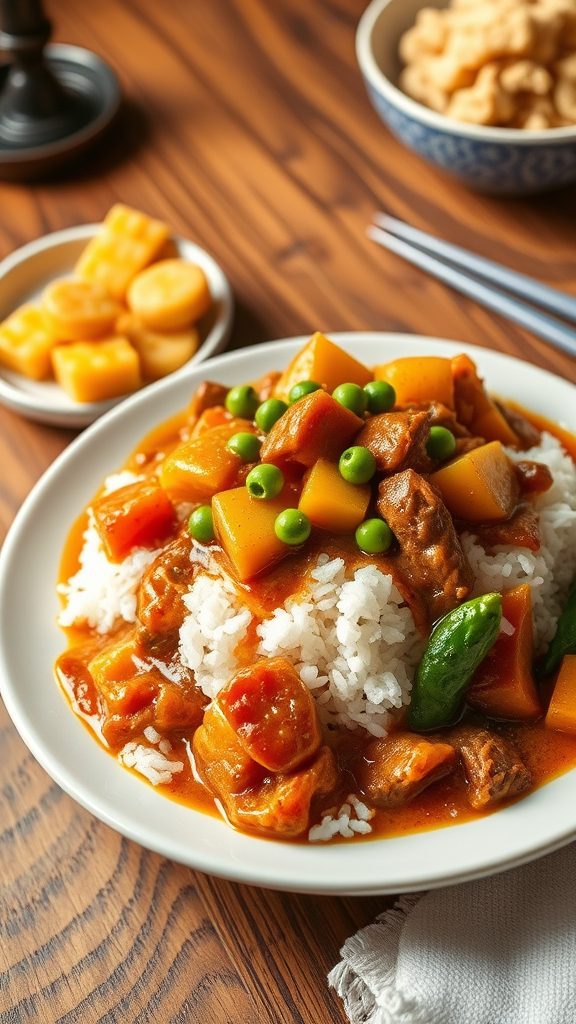
Curry Rice is a beloved staple in Japanese cuisine, offering a warm and comforting meal that is perfect for families and individuals alike. This dish features a rich and savory curry sauce served over fluffy rice, making it an ideal choice for a cozy weeknight dinner or a satisfying lunch.
Preparation time is around 30 minutes, with an additional 15 minutes for simmering, making it a quick and easy dish for both beginners and seasoned cooks.
Ingredients:
- 2 cups of Japanese short-grain rice
- 4 cups of water
- 1 onion, diced
- 2 carrots, sliced
- 2 potatoes, cubed
- 1 pound of protein (chicken, beef, or tofu), cut into bite-sized pieces
- 2 tablespoons vegetable oil
- 1 package (3.5 oz) Japanese curry roux (such as Golden Curry or Vermont Curry)
- 2 cups of water (additional for curry)
- Salt and pepper to taste
- Optional: green peas, bell peppers, or mushrooms for added vegetables
Cooking Instructions:
- Rinse the Japanese rice under cold water until the water runs clear. Drain well.
- In a rice cooker or pot, combine the rice and 4 cups of water. Cook according to your rice cooker's instructions or bring to a boil, then cover and simmer on low heat for about 18-20 minutes. Once done, let it sit covered for 10 minutes before fluffing with a fork.
- While the rice is cooking, heat the vegetable oil in a large pot or Dutch oven over medium heat. Add the diced onion and sauté until translucent.
- Add the sliced carrots and cubed potatoes to the pot, stirring occasionally for about 5 minutes.
- Add the protein to the pot and cook until browned on all sides, about 5-7 minutes.
- Pour in the additional 2 cups of water and bring to a boil. Reduce the heat to low and let it simmer for about 10 minutes, or until the vegetables are tender.
- Break the curry roux apart and add it to the pot, stirring well to dissolve. Allow the mixture to simmer for another 5-10 minutes until it thickens and develops flavor.
- Season with salt and pepper to taste.
- Serve the rich curry over fluffy rice and enjoy!
Variations and Tips:
- For a vegetarian version, substitute tofu or a mix of your favorite vegetables such as eggplant, zucchini, or bell peppers.
- Experiment with different curry roux brands to find your preferred flavor profile.
- Store leftovers in an airtight container in the refrigerator for up to 3 days; the flavors will intensify over time.
- To make it spicier, add some chili flakes or a dash of hot sauce when cooking the curry.
- Serve with a side of pickled vegetables for a traditional touch!

